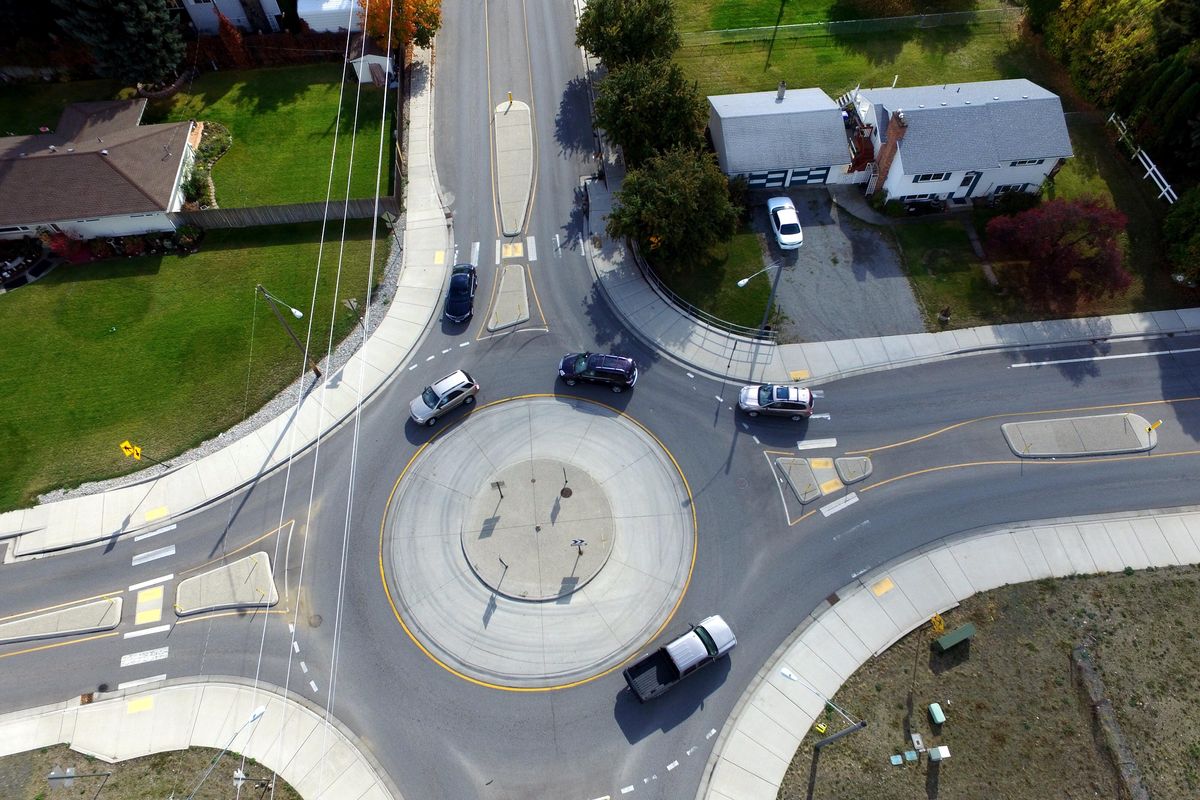Spokane goes round and round on roundabouts

Few traffic features get people as riled up as roundabouts.
“I don’t like them. I just don’t like them. This is not Europe,” said Arne Woodard, deputy mayor of Spokane Valley.
The traffic circles are designed to slip cars through gnarly intersections. Think Columbus Circle in New York City; the Arc de Triomphe in Paris; and Trafalgar Square in London.
But the corner of East Mansfield and East Montgomery Drive in Spokane Valley?
“They are confusing and a menace,” said Karrie St. Clair, of Spokane. “If people can’t remember who has the right of way in an unmarked intersection, how are they going to be able to remember what to do at a roundabout?”
The circular intersections have their fans.
“I love roundabouts,” Spokane Valley Planning Commissioner Tim Kelley offered spontaneously at a meeting Thursday after complaints about traffic congestion at the four-way stop at East Sprague Avenue and North Barker Road.
The Washington state Department of Transportation dedicated a new roundabout at the intersection of East Wellesley Avenue and North Freya Street on Monday. It’s one of about 350 roundabouts in the state.
“All are built since 1997,” Brian Walsh, WSDOT’s roundabout expert, wrote in an email.
The general reaction to roundabouts is negative in cities where they’re not widely used.
WSDOT performs community outreach and education about the rules of roundabouts, Walsh said, and after a roundabout goes in, it’s usually accepted, “albeit grudgingly.”
Andrew Staples, Liberty Lake’s city engineer, said a roundabout at Mission Avenue and Molter Road drew about 70 percent negative comments when it was proposed.
“Then after the installation, that 70-30 split flips to 70 percent being happy about it,” Staples said. “That situation applies almost universally to roundabouts in this region.”
Staples said the roundabout at Molter was put in because traffic flow there varies depending on the day.
“The roundabout means you don’t have to sit there and wait for the light to change when there’s no traffic on the weekends,” Staples said.
But drivers don’t warm up to all roundabouts.
Barb Howard lives by Spokane Valley’s Mansfield/Montgomery roundabout. “I think it’s a joke,” she said. “We have been behind cars that instead of going around to the right, just flip a left and go that way.”
Howard said drivers either don’t understand or don’t respect the yield signs.
Spokane Valley’s Donna O’Leary agreed there’s a yield issue.
“Roundabouts irritate me. People do not respect the yield signs.” O’Leary said. She said she has seen a line of drivers follow the first car into the roundabout making those in the roundabout stop. “They just keep moving right behind the first driver.”
Realizing that roundabouts are relatively new to this part of the country, both Spokane and Spokane Valley have published brochures on how to use them.
Traffic planners said there’s not much to remember except to obey the yield sign at the roundabout entrance. If there’s no one in the roundabout, or there’s enough distance to safely pull out in front of the car in the circle, drivers can enter without stopping.
The BBC published a report surmising why the British embrace roundabouts while they make Americans bristle: “The roundabout is said to have flourished in Britain because it requires the British virtues of compromise and cooperation. The U.S.’s more aggressive, confrontational culture may explain why the roundabout has not been more widely adopted by Americans.”
The Discovery television show MythBusters conducted its own brand of roundabout testing.
The show hosts determined that a roundabout is a far more effective way to move cars through a busy intersection than a four-way stop intersection. In a 15-minute period, 385 cars passed through the four-way stop versus 460 cars that coursed through the roundabout.
Yet roundabouts aren’t a cure-all and they don’t fit in just any location, said Spokane Valley Public Works Director Eric Guth.
“We look at roundabouts as a tool and we look at the data for an intersection to see if they make sense,” Guth said, adding that Spokane Valley has no plans for more roundabouts.
Statistics collected by WSDOT and the National Highway Traffic Safety Administration show that car accidents in roundabouts are fewer, and those that do occur are less severe than accidents at regular intersections.
That’s one reason WSDOT is proposing two new roundabouts on Highway 395 in Deer Park.
There have been at least 10 intersection-related crashes in that area since the study began in 2015.
“We took a lot of grief when we planned the first one, and once it went in people were fine,” said Debbie Cragun, Deer Park city clerk and treasurer.
The roundabout’s smaller cousin, the traffic circle, is not as common in Spokane as in larger cities. A traffic circle may be as simple as the one in Browne’s Addition at Cannon Street and Pacific Avenue, which is little more than a planter in the middle of a four-way intersection.
Julie Biggerstaff, treasurer of Browne’s Addition’s Neighborhood Council, said the council hears few complaints about the circle.
“I’d say the consensus is people like the traffic circle,” Biggerstaff said. “It forces people to slow down around the businesses.”